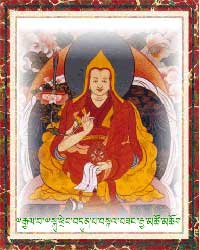bskal bzang rgya mtsho
This is the RYI Dictionary content as presented on the site http://rywiki.tsadra.org/, which is being changed fundamentally and will become hard to use within the GoldenDict application. If you are using GoldenDict, please either download and import the rydic2003 file from DigitalTibetan (WayBack Machine version as the site was shut down in November 2021).
Or go directly to http://rywiki.tsadra.org/ for more upcoming features.
བསྐལ་བཟང་རྒྱ་མཚོ
Kalsang Gyatso (1708-1757). the Seventh Dalai Lama; Dalai lama vii, 1708-1757 [RY]
Kalsang Gyatso, 7th Dalai Lama [IW]
Kalsang gyatso [1708-1757) 7th Dalai Lama [born Amdo khams south in li thang. In the 12th rabjung earth mouse year. In its iron mouse year by Emperor khang shis's decree came to Lhasa rtze palace's golden throne. From the earth monkey to the wood tiger bod du sde gzar byung rkyen khams mgar thar du chibs bsgyur gnang. In the 13th rabjung iron horse year according to the command of Emperor chin lung in rtze pho brang he received royal rule, dying in the fire ox year] [IW]
The Seventh Dalai Lama, Kelsang Gyatso, in retrospect, Tibetans believed that Tsangyang Gyatso predicted his own rebirth at Lithang in Kham when he wrote this song:
"White crane, lend me your wings,
I go no farther than Lithang,
And thence, return again."
Sure enough, the Seventh Dalai Lama was born in 1708 to Sonam Dargya and Lobsang Chotso in Lithang, two years after the disappearance of the Sixth.
Thupten Jampaling Monastery, which was founded in Lithang by the Third Dalai Lama, was astonished by the wonders of the child and also the state oracles of Lithang had predicted that the newborn child would be the reincarnation of the late Dalai Lama. However due to the turbulent political situation, they could not escort the new Dalai Lama to Lhasa, and he was taken to Kumbum monastery, where he was ordained by Ngawang Lobsang Tenpai Gyaltsen.
In 1720, he was enthroned in the Potala Palace and he took the novice vows of monkhood from Panchen Lobsang Yeshi, who gave him the name Kelsang Gyatso. In 1726, during the auspicious month of Saka Dawa, he took the Gelong vows (full ordination) from Panchen Rinpoche. He sought the tutor of Panchen Lobsang Yeshi, the Abbot of Gyumey monastery and the Abbot of Shalu monastery, Ngawang Yonten, from whom he studied the entire major Buddhist philosophical treatises and became a master in both the sutra and tantra.
In 1751, at the age of forty-three, he constituted the 'Kashag' or council of ministers to administer the Tibetan government and then abolished the post of Desi, as it placed too much power in one man's hand. The Dalai Lama became the spiritual and political leader of Tibet. At the age of forty-five, he founded the Tse-School in the Potala Palace and built the new palace of Norling Kalsang Phodrang. The Seventh Dalai Lama was a great scholar and wrote many books, especially on the tantra. He was also a great poet who, unlike Tsangyang Gyatso, dwelt on spiritual themes. His simple and unblemished life won him the hearts of all Tibetans. He died in 1757.
